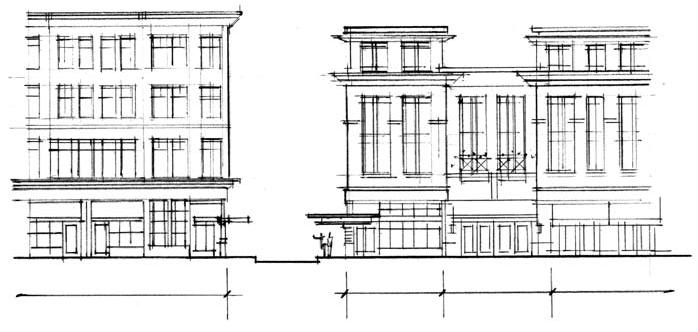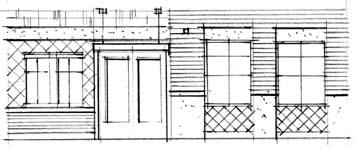Chapter 18.120
COMMERCIAL DESIGN CRITERIA DOWNTOWN
18.120.000 Chapter Contents
Sections:
18.120.020 Setbacks.
18.120.030 Waterfront view corridors.
18.120.040 Parking lots.
18.120.050 Building design.
18.120.060 Building materials.
18.120.070 Building design –Building rhythm.
18.120.080 Building orientation.
18.120.090 Awnings, canopies, and marquees.
18.120.100 Walkways.
18.120.110 Pedestrian access from parking areas.
18.120.120 Waterfront public access.
18.120.130 Visual context of streetscape.
18.120.140 Signs - Attached to the building.
18.120.150 Signs - Freestanding.
(Ord. 6306 §4, 2004).
18.120.020 Setbacks
A. REQUIREMENT: Maintain the continuity of the streetscape with the setbacks of buildings.
B. GUIDELINES:
1. Align buildings according to the existing pattern.
2. Use walls, railings, planters, or other built and landscape elements at the property line if the building or a portion of it is set back from the property line.
(See Also Pedestrian Streets Overlay, Chapter 18.16.)
FIGURE 18.120.020
(Ord. 6306 §4, 2004).
18.120.030 Waterfront view corridors
A. REQUIREMENT:
On waterfront sites, provide for public view corridors of Capitol Lake and Budd Inlet. All development shall incorporate into the site and building design both territorial and immediate views for significant numbers of people from public rights-of-way. (EXCEPT: Intermittent or partial views of the water may not be deemed necessary to incorporate into the site and building design.) See Scenic Vista overlay zoning maps, which are available at the Community Planning and Development Department.
(See also Pedestrian Streets Overlay, OMC 18.16)
B. GUIDELINES:
1. Locate buildings on the site and design roofs so that they do not interfere with views and vistas.
2. Design and site waterfront buildings to avoid blocking view corridors on adjacent streets that point toward the water.
FIGURE 18.120.030
(Ord. 6306 §4, 2004).
18.120.040 Parking lots
A. REQUIREMENT: Locate and design parking lots which maintain the visual continuity of the street and do not create vacant space in the street pattern. Allow for both pedestrian and vehicular circulation, and provide clear access between parking and the principal building(s) on the site.
(See also Section 18.38.160, Specific Zone District Requirements, and Chapter 18.16, Pedestrian Streets Overlay.)
B. GUIDELINES:
1. Minimize the width of parking lots located adjacent to the street.
2. Screen parking lots which abut the street with hedges, fences, raised planters, or low walls combined with plantings. These screening materials shall not obscure vehicular sight lines as a safety requisite. (See Section 18.38.200, Parking Facility Location.)

FIGURE 18.120.040
(Ord. 6306 §4, 2004).
18.120.050 Building design
A. REQUIREMENT: Buildings must have streetscape characteristics, such as pedestrian oriented businesses and/or shops, corner entries, and building edges abutting the sidewalk. For additional Building Design requirements please refer to:
1. Development Standards in the zoning district where the project is located, and,
2. Pedestrian Streets Overlay District (OMC 18.16).
FIGURE 18.120.050
(Ord. 6306 §4, 2004).
18.120.060 Building materials
A. REQUIREMENT: Maintain the character of the existing downtown buildings by using similar enduring materials such as stone, brick, and stucco.
B. GUIDELINE: Applied brick tiles or exterior insulation finish system (EIFS) that attempt to give the appearance of genuine masonry or stucco are not preferred. Decorative ceramic tiles may be used as accent features.
FIGURE 18.120.060-A
FIGURE 18.120.060-B
(Ord. 6306 §4, 2004).
18.120.070 Building design –Building rhythm
A. REQUIREMENT: Create visually interesting street walls with variations in horizontal and vertical wall surfaces. Use architectural elements that clearly define a base at street level.
B. GUIDELINE: Provide variation in fenestration, architectural elements, building materials, and/or building planes at varying intervals. (See also Basic Commercial Design Criteria, 18.110.080 Maintaining Human Scale, for additional direction.)
FIGURE 18.120.070
(Ord. 6306 §4, 2004).
18.120.080 Building orientation
A. REQUIREMENT: Orient the primary building entrance and active uses such as retail storefront window displays or restaurants to the street. (See also Chapter 18.16, Pedestrian Streets Overlay District.)
B. GUIDELINES:
1. Provide views and access into interior activities of the building from the street. Use a high proportion of glazing at the street level for displays or to reveal services available.
2. Use landscaping, surface texture, or art work on buildings where revealing active uses is inappropriate.
FIGURE 18.120.080-A
FIGURE 18.120.080-B
(Ord. 6306 §4, 2004).
18.120.090 Awnings, canopies, and marquees
A. REQUIREMENT: Provide awnings, canopies, and marquees on buildings that abut the sidewalk. (See also Chapter 18.16, Pedestrian Streets Overlay District.)
B. GUIDELINES:
1. Maintain the visual and spatial horizontal plane of the street by employing a horizontal alignment of awnings, canopies, and marquees in areas where they are an existing element in the street pattern.
2. Select awnings, canopies, and marquees which emphasize the architectural and/or historical character, color, and material of the building without covering or obscuring details of the facade.
3. Provide continuity of coverage on both sides and the corner when a building is located on a corner.
FIGURE 18.120.090
(Ord. 6306 §4, 2004).
18.120.100 Walkways
A. REQUIREMENT: Provide character and visual diversity to walkways.
B. GUIDELINES:
1. Vary sidewalk colors and materials by combining pavers, brick, stone, exposed aggregate and other materials set in geometric or free form patterns.
2. Identify street and driveway crossings through changes in colors, materials, or patterns.
3. Separate the pedestrian from the street by the use of planters, bollards, or similar elements at the street edge of the sidewalk.
4. Provide alleys with lighting, plantings, and paving materials in areas of the City where the alley is or may be used as a pedestrian link.
5. Incorporate information about historic events or structures into the walkway by use of plaques, signs, and art work.

FIGURE 18.120.100
(Ord. 6306 §4, 2004).
18.120.110 Pedestrian access from parking areas
A. REQUIREMENT: Provide direct and visible pedestrian access through parking areas to building entrances and to adjoining pedestrian ways. Minimize crossings of traffic lanes.
B. GUIDELINES:
1. Provide sidewalks through parking bays.
2. Define walkways with vertical plantings, such as trees or shrubs.
3. Use materials, textures, patterns, or colors to differentiate pedestrian paths from parking areas. Use non-slip materials.
4. Emphasize the entrance to the building by the use of paving materials and landscaping. Avoid locating parking spaces directly in front of the building entrance or in such a way as to interfere with entrance visibility and access.
5. Use signs to direct customers to the building entrances and back to the parking areas.

FIGURE 18.120.110-A
FIGURE 18.120.110-B
(Ord. 6306 §4, 2004).
18.120.120 Waterfront public access
A. REQUIREMENTS: On waterfront sites used for commercial, residential, or recreational uses, incorporate shoreline public access pursuant to the goals of the Shoreline Management Act in a manner roughly proportionate to the impact created by the development.
B. GUIDELINES:
1. Provide a water-edge trail and view corridors.
2. Provide public access to the water-edge trail and/or view corridors.
3. Provide necessary improvements appropriate to these facilities, such as signage, seating, and lighting.
FIGURE 18.120.120
(Ord. 6306 §4, 2004).
18.120.130 Visual context of streetscape
A. REQUIREMENT: Develop visual linkages between adjacent properties through building design, street trees, and streetscape improvements.
B. GUIDELINES:
1. Link dissimilar buildings by using common elements of existing development. Maintain setbacks from the street; repeat or incorporate similar proportions and scale of buildings; use similar exterior materials, paving materials, and lighting standards.
2. Plant the same or similar street trees to maintain the continuity of the street.
3. Continue walls, screening, and planters where they exist.
4. Repeat common elements and/or materials of landscape design.
FIGURE 18.120.130
(Ord. 6306 §4, 2004).
18.120.140 Signs –Attached to the building
A. REQUIREMENT: Choose signs that maintain the architectural integrity of the building; locate them so the building details are not covered or obscured. Signs shall conform with Chapter 18.42, Signs, and to the design requirements of this section and of section 18.120.150.
B. GUIDELINES:
1. Signs should be subordinate to the building design.
2. Coordinate colors with the colors of the building.
3. Use sign panel shapes that complement the architectural forms of the building.
4. Avoid a wide variety of types and sizes of signs when several businesses share the same building. Use directory signs wherever possible.
5. Select colors, materials, size, shape, and illumination similar to signs found on adjacent properties. Emphasize legibility and simplicity.
6. Align signs with those on adjacent buildings when possible.
7. Design signs for businesses served principally by vehicular traffic to be easily legible from the street.
8. Select lettering sizes, styles, and sign locations that will be clearly visible to pedestrians.
9. Use window signs where wall signs would detract from architectural elements of building facade. Symbols for the business such as a pair of eyeglasses can be used to add detail at the sidewalk.
10. Select a type and intensity of lighting in order to match the lighting levels of signs found in the area.
FIGURE 18.120.140
(Ord. 6306 §4, 2004).
18.120.150 Signs –Freestanding
A. REQUIREMENTS: When building-mounted signs will obscure the architectural details of the building or where buildings are set back from the sidewalk and/or property line, use a free-standing sign. Signs shall conform to Chapter 18.42 Signs.
Signs shall have a maximum height of four (4) feet above grade. Lettering styles and colors are limited to two (2) lettering styles and three (3) colors. Signs shall be incorporated in planters or screening walls.
FIGURE 18.120.150
(Ord. 6306 §4, 2004).


